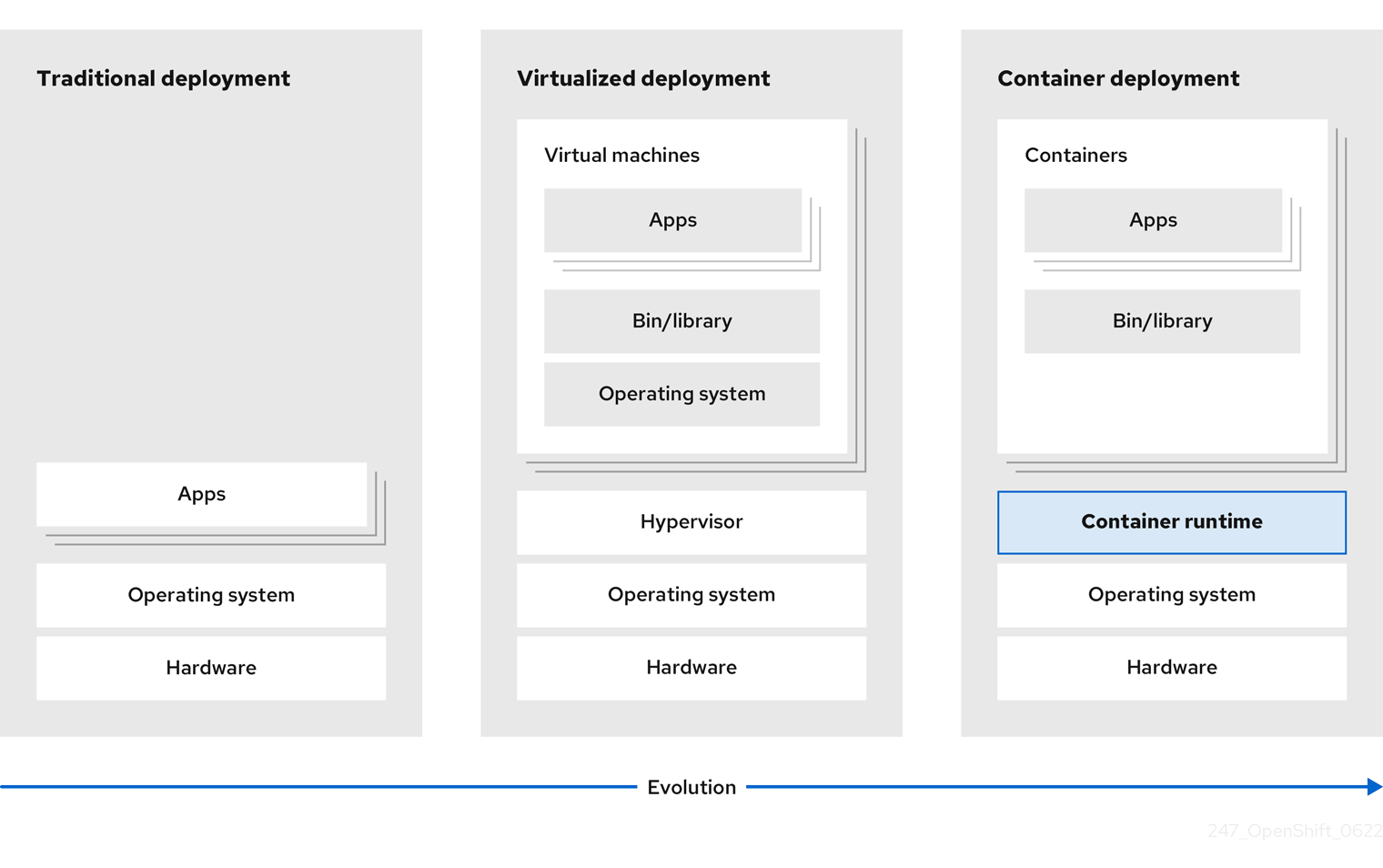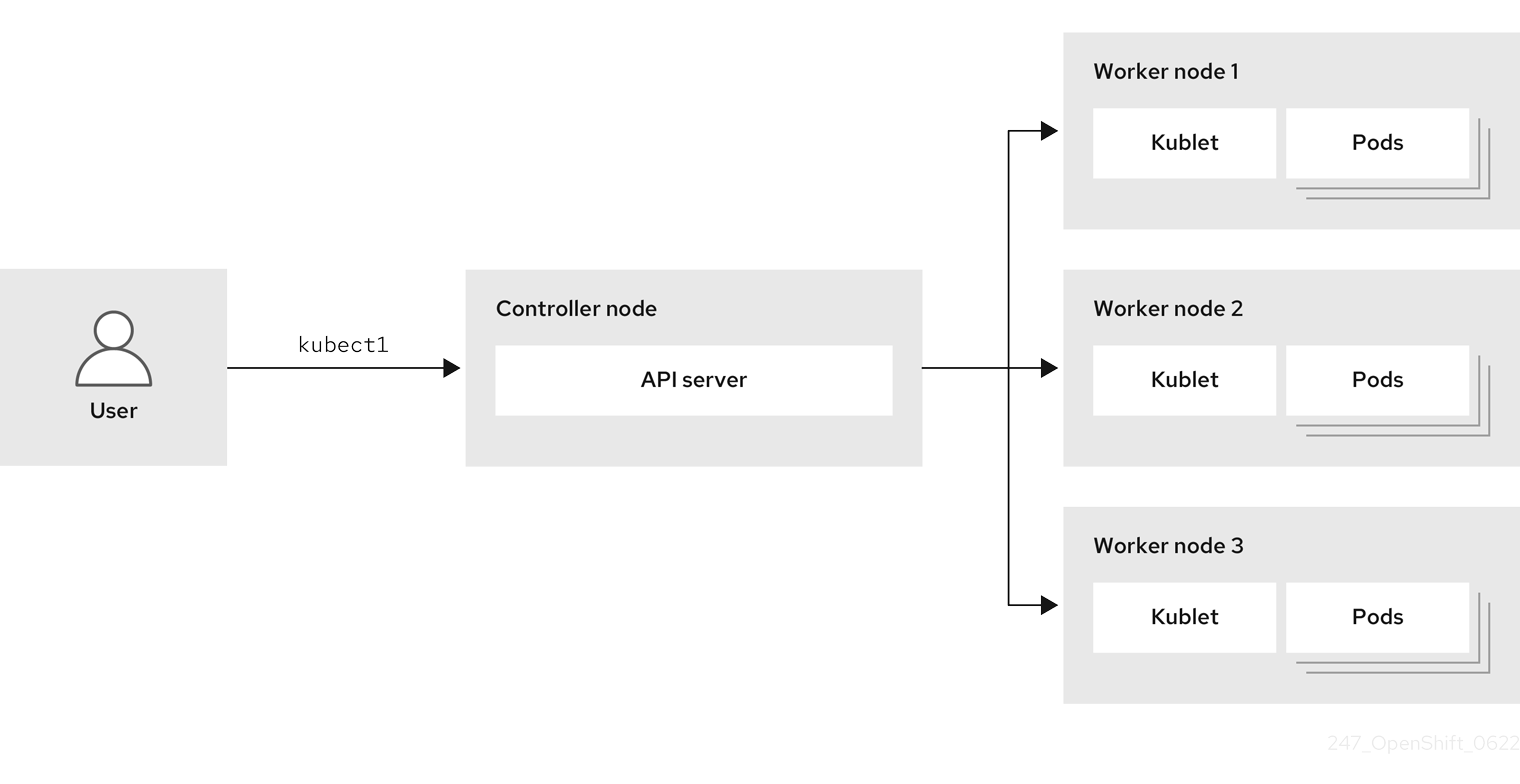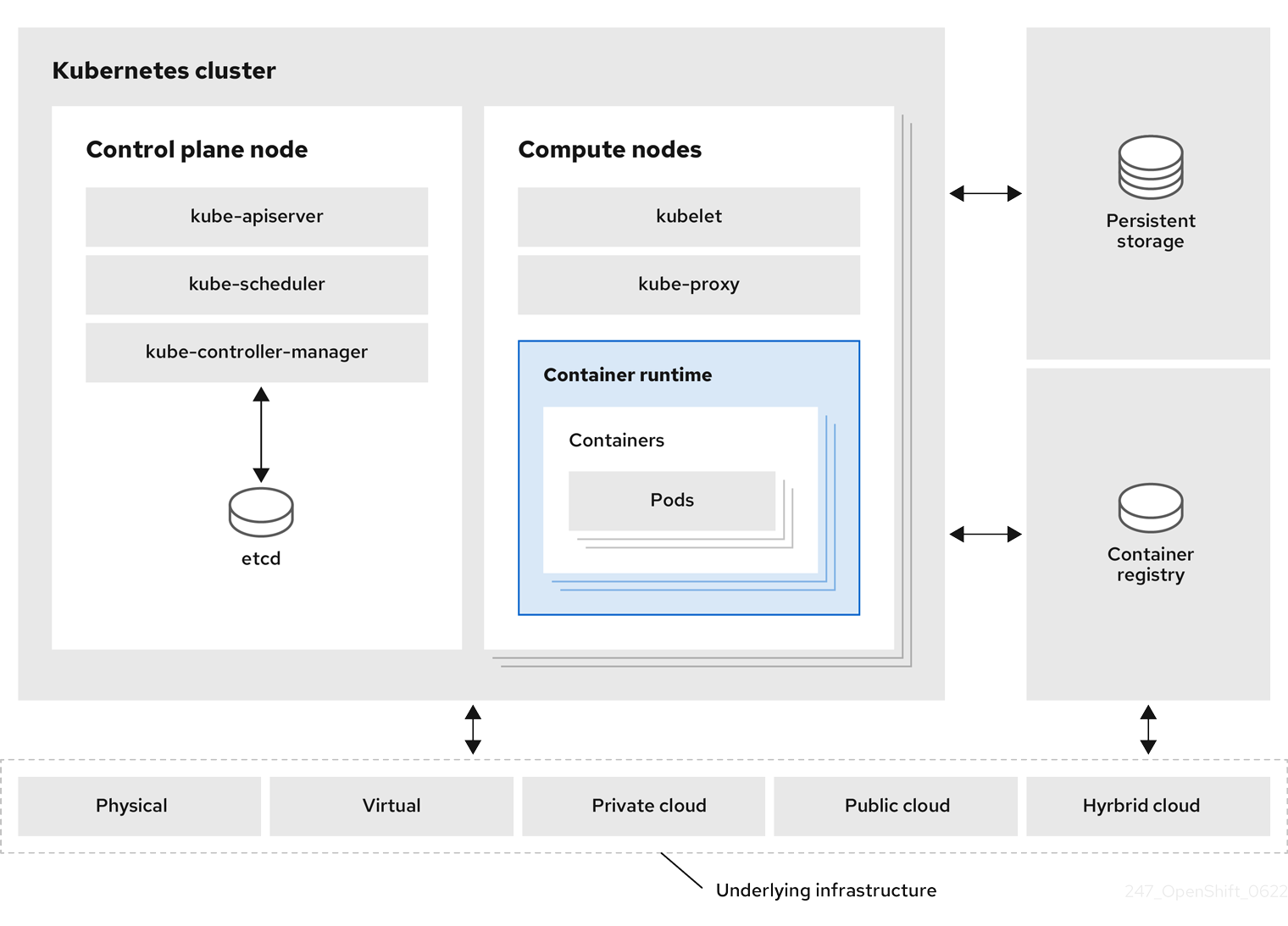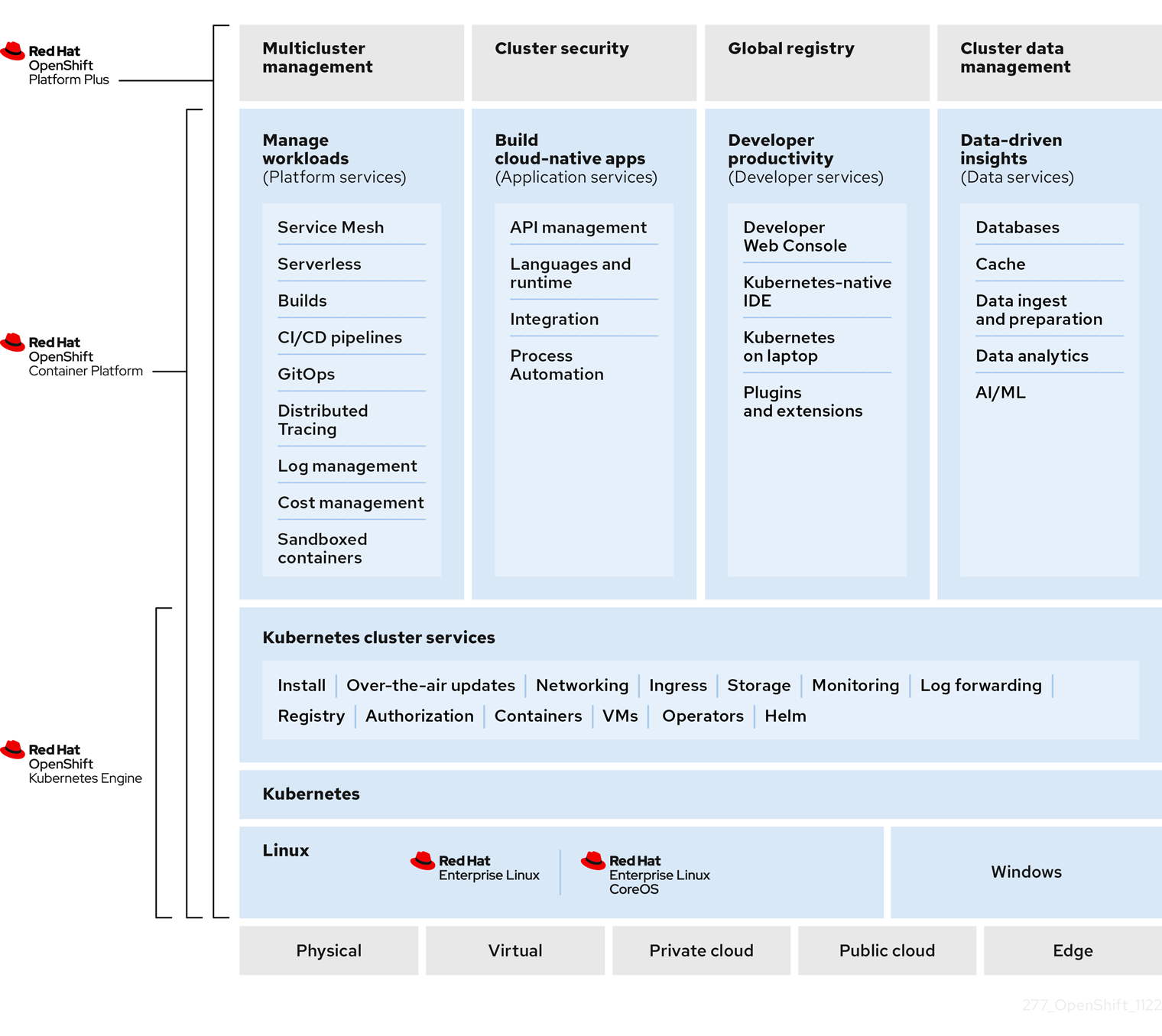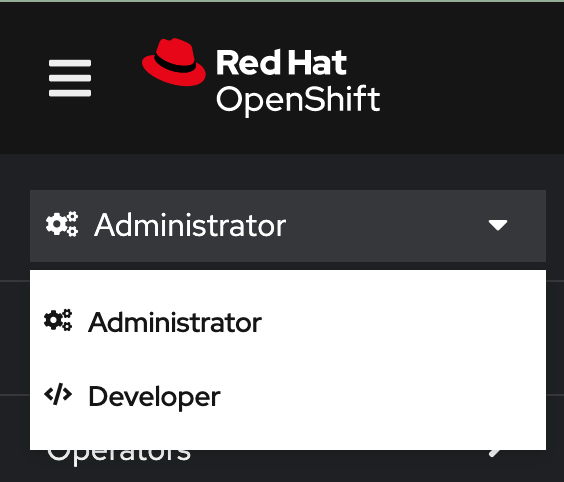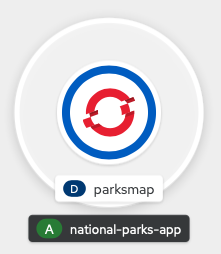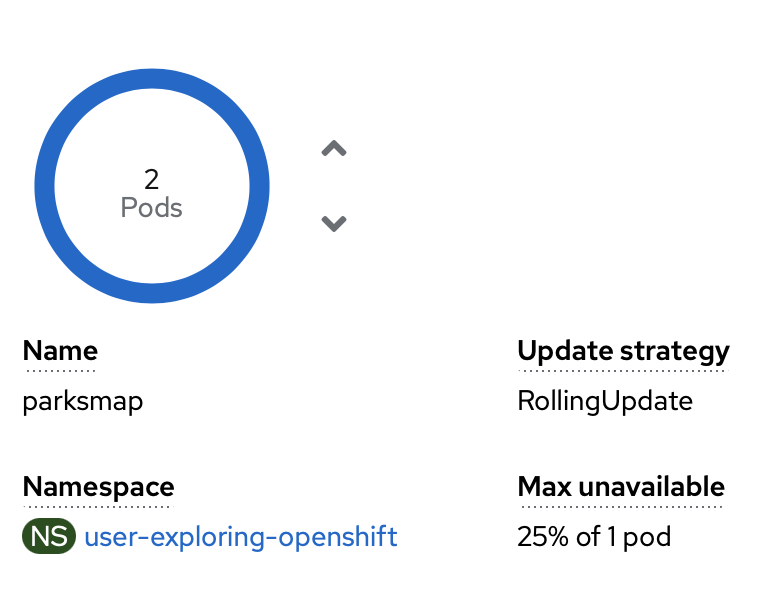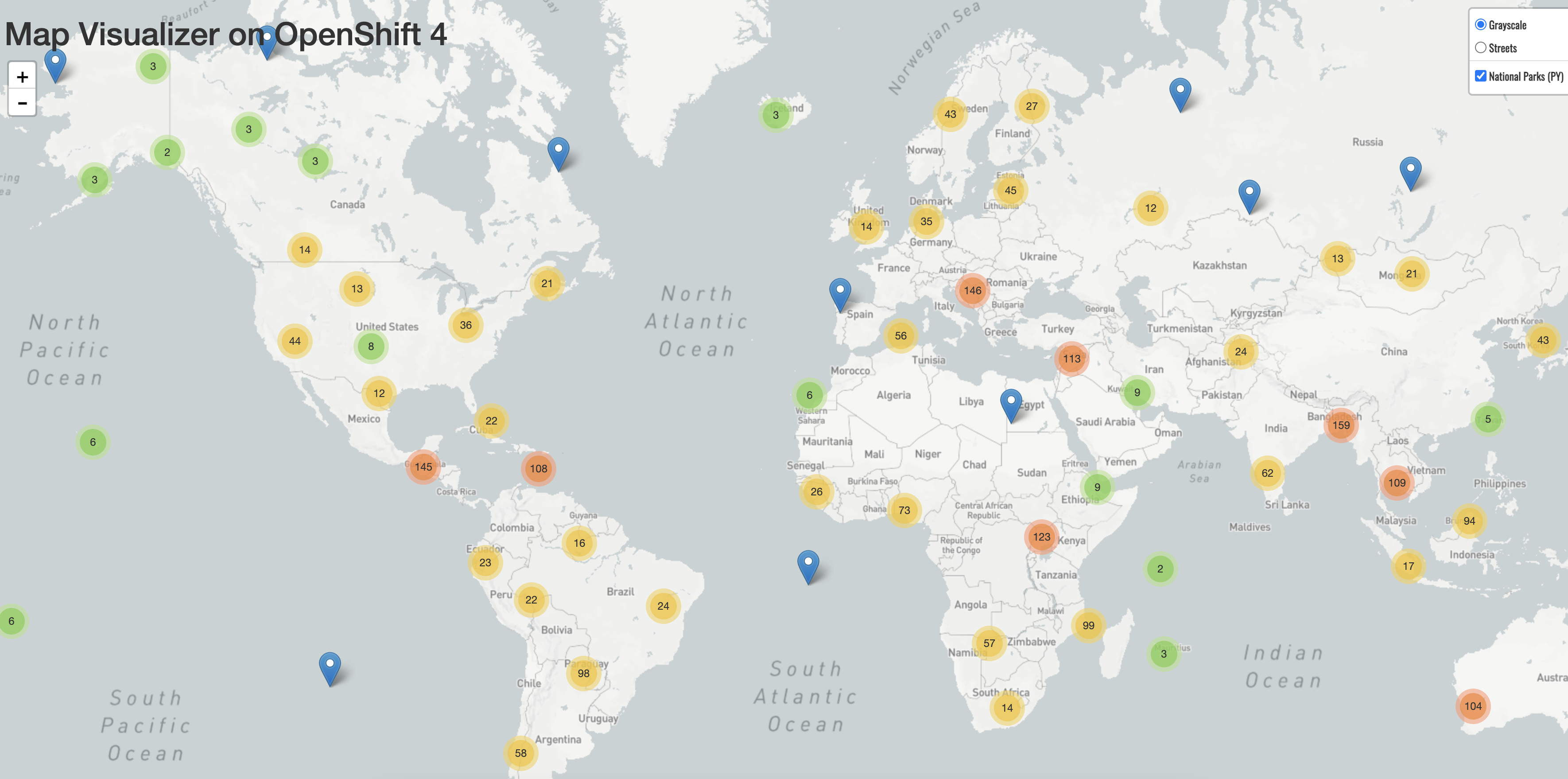スタートガイド
OpenShift Container Platform のスタートガイド
概要
第1章 Kubernetes の概要
Kubernetes は、Google が開発したオープンソースのコンテナーオーケストレーションツールです。Kubernetes を使用して、コンテナーベースのワークロードを実行および管理できます。最も一般的な Kubernetes のユースケースは、相互接続されたマイクロサービスのアレイをデプロイし、クラウドネイティブな方法でアプリケーションを構築することです。オンプレミス、パブリック、プライベート、またはハイブリッドクラウド全体のホストにまたがることができる Kubernetes クラスターを作成できます。
従来、アプリケーションは単一のオペレーティングシステムの上にデプロイされていました。仮想化を使用すると、物理ホストを複数の仮想ホストに分割できます。共有リソース上の仮想インスタンスで作業することは、効率やスケーラビリティの面で最適とは言えません。仮想マシン (VM) は物理マシンと同じ数のリソースを消費するため、CPU、RAM、ストレージなどのリソースを VM に提供するとコストがかかる可能性があります。また、共有リソースでの仮想インスタンスの使用により、アプリケーションのパフォーマンスが低下する場合があります。
図1.1 従来のデプロイメント向けのコンテナーテクノロジーの進化
この問題を解決するには、コンテナー化された環境でアプリケーションを分離するコンテナー化テクノロジーを使用することができます。VM と同様に、コンテナーには独自のファイルシステム、vCPU、メモリー、プロセススペース、依存関係などがあります。コンテナーは基盤となるインフラストラクチャーから切り離されており、クラウドや OS ディストリビューション間で移植可能です。コンテナーは本来、全機能を備えた OS よりもはるかに軽量で、オペレーティングシステムカーネルで実行される軽量の分離されたプロセスです。仮想マシンは、(コンテナーよりも) 起動に時間がかかり、物理ハードウェアを抽象化したものです。VM は、ハイパーバイザーを使用して単一のマシンで実行されます。
Kubernetes を利用すると、以下のようなアクションを行うことができます。
- リソースの共有
- 複数のホストにまたがるコンテナーのオーケストレーション
- 新しいハードウェア設定のインストール
- ヘルスチェックと自己修復アプリケーションの実行
- コンテナー化されたアプリケーションのスケーリング
1.1. Kubernetes コンポーネント
| コンポーネント | 目的 |
|---|---|
|
| クラスター内のすべてのノードで実行され、Kubernetes リソース間のネットワークトラフィックを維持します。 |
|
| クラスターの状態を管理します。 |
|
| Pod をノードに割り当てます。 |
|
| クラスターデータを保存します。 |
|
| API オブジェクトのデータを検証および設定します。 |
|
| ノード上で実行され、コンテナーマニフェストを読み取ります。定義されたコンテナーが開始され、実行されていることを確認します。 |
|
|
ワークロードの実行方法を定義できるようにします。 |
| Node | ノードは、Kubernetes クラスター内の物理マシンまたは VM です。コントロールプレーンはすべてのノードを管理し、Kubernetes クラスター内のノード全体で Pod をスケジュールします。 |
| コンテナーランタイム | コンテナーランタイムは、ホストオペレーティングシステムでコンテナーを実行します。Pod をノードで実行できるように、各ノードにコンテナーランタイムをインストールする必要があります。 |
| 永続ストレージ | デバイスがシャットダウンされた後でもデータを保存します。Kubernetes は永続ボリュームを使用して、アプリケーションデータを保存します。 |
|
| コンテナーイメージを保存してアクセスします。 |
| Pod | Pod は、Kubernetes における最小の論理単位です。Pod には、ワーカーノードで実行する 1 つ以上のコンテナーが含まれています。 |
1.2. Kubernetes リソース
カスタムリソースは、Kubernetes API のエクステンションです。カスタムリソースを使用して、Kubernetes クラスターをカスタマイズできます。Operator は、カスタムリソースを使用してアプリケーションとそのコンポーネントを管理するソフトウェアエクステンションです。Kubernetes は、クラスターリソースの処理中に一定の望ましい結果を得る必要がある場合に、宣言型モデルを使用します。Operator を使用することで、Kubernetes は宣言的な方法で状態を定義します。命令型コマンドを使用して、Kubernetes クラスターリソースを変更できます。Operator は、リーソスの目的とされる状態と、実際の状態を継続的に比較して、実際の状態を目的の状態と合わせられるようにアクションを実行します。
図1.2 Kubernetes クラスターの概要
| リソース | 目的 |
|---|---|
| Service | Kubernetes はサービスを使用して、実行中のアプリケーションを一連の Pod に公開します。 |
|
|
Kubernetes は |
| Deployment | アプリケーションのライフサイクルを維持するリソースオブジェクト。 |
Kubernetes は、OpenShift Container Platform のコアコンポーネントです。OpenShift Container Platform は、コンテナー化されたアプリケーションの開発および実行に使用できます。Kubernetes を基盤とする OpenShift Container Platform には、大規模な通信、ビデオストリーミング、ゲーム、銀行取引、およびその他のアプリケーションのエンジンと同様のサービスを提供する技術が組み込まれています。OpenShift Container Platform を使用することで、コンテナー化されたアプリケーションを単一のクラウドを超えてオンプレミスおよびマルチクラウド環境へと拡張することができます。
図1.3 Kubernetes のアーキテクチャー
クラスターは、クラウド環境内の複数のノードで構成される単一の計算ユニットです。Kubernetes クラスターには、コントロールプレーンとワーカーノードが含まれます。さまざまなマシンや環境で Kubernetes コンテナーを実行できます。コントロールプレーンノードは、クラスターの状態を制御および維持します。ワーカーノードを使用して Kubernetes アプリケーションを実行できます。Kubernetes の namespace を使用して、クラスター内のクラスターリソースを区別できます。namespace のスコープは、デプロイメント、サービス、Pod などのリソースオブジェクトに適用できます。ストレージクラス、ノード、永続ボリュームなどのクラスター全体のリソースオブジェクトに、namespace を使用することはできません。
1.3. Kubernetes の概念ガイドライン
OpenShift Container Platform を使い始める前に、以下に示す、概念面での Kubernetes のガイドラインを考慮してください。
- 1 つまたは複数のワーカーノードを使用することからスタートし、コンテナーのワークロードを実行します。
- 1 つまたは複数のコントロールプレーンノードからワークロードのデプロイを管理します。
- Pod と呼ばれるデプロイメント単位にコンテナーをラップします。Pod を使うことでコンテナーに追加のメタデータが付与され、複数のコンテナーを単一のデプロイメントエンティティーにグループ化する機能が提供されます。
- 特殊な種類のアセットを作成します。たとえば、サービスは一連の Pod とそのアクセス方法を定義するポリシーによって表されます。このポリシーにより、コンテナーはサービス用の特定の IP アドレスを持っていない場合でも、必要とするサービスに接続することができます。レプリケーションコントローラーは、一度に実行するのに必要な Pod レプリカ数を示すもう一つの特殊なアセットです。この機能を使うと、現在の需要に対応できるようにアプリケーションを自動的にスケーリングすることができます。
OpenShift Container Platform クラスターへの API は 100% Kubernetes です。他の Kubernetes で実行されているコンテナーと OpenShift Container Platform で実行されているコンテナーの間では、何も変更はありません。アプリケーションに変更はありません。OpenShift Container Platform は、Kubernetes にエンタープライズ対応の拡張機能を提供する付加価値機能をもたらします。OpenShift Container Platform CLI ツール (oc) は kubectl と互換性があります。Kubernetes API は OpenShift Container Platform 内で 100% アクセス可能ですが、kubectl コマンドラインには使いやすい機能があまりありません。OpenShift Container Platform は、oc のような一連の機能とコマンドラインツールを提供します。Kubernetes はアプリケーションの管理には優れていますが、プラットフォームレベルの要件やデプロイメントプロセスの指定や管理には対応しません。OpenShift Container Platform が提供する強力かつ柔軟なプラットフォーム管理ツールとプロセスは、重要な利点となります。コンテナー化プラットフォームに、認証、ネットワーキング、セキュリティー、監視、およびログ管理を追加する必要があります。
第2章 OpenShift Container Platform の概要
OpenShift Container Platform は、クラウドベースの Kubernetes コンテナープラットフォームです。OpenShift Container Platform の基盤は、Kubernetes に基づいているため、同じテクノロジーを共有しています。アプリケーションおよびアプリケーションをサポートするデータセンターで、わずか数台のマシンとアプリケーションから、何百万ものクライアントに対応する何千ものマシンに拡張できるように設計されています。
OpenShift Container Platform を使用すると、以下を実行できます。
- 開発者および IT 組織に、セキュアでスケーラブルなリソースへのアプリケーションのデプロイに使用できる、クラウドアプリケーションプラットフォームを提供する。
- 設定および管理のオーバーヘッドを最小限に抑える。
- Kubernetes プラットフォームをお客様のデータセンターおよびクラウドに導入する。
- セキュリティー、プライバシー、コンプライアンス、ガバナンスの要件を満たす。
Kubernetes を基盤とする OpenShift Container Platform には、大規模な通信、ビデオストリーミング、ゲーム、銀行取引、およびその他のアプリケーションのエンジンと同様にサービスを提供する技術が組み込まれています。Red Hat のオープンテクノロジーに実装することで、コンテナー化されたアプリケーションを、単一クラウドを超えてオンプレミスおよびマルチクラウド環境へと拡張することが可能です。
2.1. OpenShift Container Platform の共通用語集
この用語集では、一般的な Kubernetes および OpenShift Container Platform の用語を定義します。
- Kubernetes
- Kubernetes は、コンテナー化されたアプリケーションのデプロイ、スケーリング、管理を自動化するための、オープンソースのコンテナーオーケストレーションエンジンです。
- コンテナー
- コンテナーは、ワーカーノードの OCI 準拠のコンテナーで実行されるアプリケーションインスタンスおよびコンポーネントです。コンテナーは、Open Container Initiative (OCI) 準拠のイメージのランタイムです。イメージはバイナリーアプリケーションです。ワーカーノードは、多数のコンテナーを実行できます。ノードの能力は、ベースとなるリソースがクラウド、ハードウェア、または仮想化のいずれであっても、そのリソースのメモリーおよび CPU の機能に関連します。
- Pod
Pod は、1 つのホスト上に共にデプロイされる 1 つまたは複数のコンテナーです。一緒に配置されたコンテナーのグループおよびボリュームや IP アドレスなどの共有リソースで構成されます。Pod は、定義、デプロイ、および管理される最小のコンピュート単位でもあります。
OpenShift Container Platform では、Pod はデプロイ可能な最小単位として個別のアプリケーションコンテナーに代わるものです。
Pod は、OpenShift Container Platform ではオーケストレーションされた単位です。OpenShift Container Platform は、同じノード上の Pod のすべてのコンテナーをスケジュールし、実行します。複雑なアプリケーションは数多くの Pod で構成され、それぞれが独自のコンテナーを持ちます。これらは外部と連携し、また OpenShift Container Platform 環境内で相互に連携します。
- レプリカセットおよびレプリケーションコントローラー
- Kubernetes のレプリカセットと OpenShift Container Platform のレプリケーションコントローラーの両方が利用可能です。このコンポーネントの役割は、指定された数の Pod レプリカが常時実行されるようにすることです。Pod が終了または削除されると、レプリカセットまたはレプリケーションコントローラーが別の Pod を起動します。必要以上の Pod が実行されている場合、指定されたレプリカ数となるように、レプリカセットは必要な数だけ削除します。
- Deployment および DeploymentConfig
OpenShift Container Platform は、Kubernetes の
Deploymentオブジェクトと OpenShift Container Platform のDeploymentConfigsオブジェクトの両方を実装します。ユーザーはどちらかを選択できます。Deploymentオブジェクトは、アプリケーションを Pod としてロールアウトする方法を制御します。これらは、レジストリーから取得してノード上に Pod としてデプロイするコンテナーイメージの名前を特定します。デプロイする Pod のレプリカ数を設定し、プロセスを管理するレプリカセットを作成します。示されるラベルは、Pod をデプロイするノードをスケジューラーに指示します。ラベルのセットは、レプリカセットがインスタンス化する Pod 定義に含まれます。Deploymentオブジェクトは、Deploymentオブジェクトのバージョンと、許容されるアプリケーションの可用性を管理するための各種のロールアウトストラテジーに基づいて、ワーカーノードにデプロイされる Pod を更新できます。OpenShift Container Platform のDeploymentConfigオブジェクトにはさらに変更トリガーの機能が追加され、新しいバージョンのコンテナーイメージが利用可能になったり、その他の変更が生じたりすると、新しいバージョンのDeploymentオブジェクトを自動的に作成できます。- サービス
サービスは、Pod の論理セットとアクセスポリシーを定義します。Pod が作成および破棄されるときに使用する他のアプリケーションの永続的な内部 IP アドレスおよびホスト名を提供します。
サービス層は、アプリケーションコンポーネント同士を結合します。たとえば、フロントエンドの Web サービスは、そのサービスと通信してデータベースインスタンスに接続します。サービスを使用すると、アプリケーションコンポーネント間の単純な内部負荷分散が可能になります。OpenShift Container Platform は、検出を容易にするために、サービス情報を実行中のコンテナーに自動的に挿入します。
- ルート
- ルートは、www.example.com などの外部から到達可能なホスト名を指定して、サービスを公開する手段です。各ルートは、ルート名、サービスセレクター、セキュリティー設定 (任意) で構成されます。ルーターは、定義されたルートやそのサービスによって識別されるエンドポイントを使用して、外部クライアントがアプリケーションへの到達に使用できる名前を指定できます。完全なマルチレイヤーのアプリケーションをデプロイすることは簡単ですが、OpenShift Container Platform 環境外からのトラフィックは、ルーティングレイヤーがないとアプリケーションに到達できません。
- ビルド
-
ビルドとは、入力パラメーターを結果として作成されるオブジェクトに変換するプロセスです。ほとんどの場合、このプロセスは入力パラメーターまたはソースコードを実行可能なイメージに変換するために使用されます。
BuildConfigオブジェクトはビルドプロセス全体の定義です。OpenShift Container Platform は、ビルドイメージからコンテナーを作成し、それらを統合レジストリーにプッシュすることで、Kubernetes を活用します。 - プロジェクト
OpenShift Container Platform はプロジェクトを使用して、ユーザーや開発者のグループが連携できるようにし、分離およびコラボレーションの単位として機能します。リソースのスコープを定義し、プロジェクト管理者およびコラボレーターがリソースを管理できるようにし、クォータや制限でユーザーのリソースを制限し、追跡します。
プロジェクトは、追加のアノテーションを備えた Kubernetes namespace です。これは、通常ユーザーのリソースへのアクセスを管理する中心的な手段です。プロジェクトにより、ユーザーコミュニティーは、他のコミュニティーと切り離された状態で独自のコンテンツを整理し、管理することができます。ユーザーは、管理者からプロジェクトへのアクセス権限を受け取る必要があります。ただし、クラスター管理者は、開発者が専用のプロジェクトを作成するのを許可できます。この場合、ユーザーは自動的に専用のプロジェクトにアクセスできます。
各プロジェクトには、オブジェクト、ポリシー、制約、およびサービスアカウントの独自のセットがあります。
プロジェクトは namespace としても知られています。
- Operator
Operator は Kubernetes ネイティブアプリケーションです。Operator の目的は、運用上の知識をソフトウェアに配置することです。従来、この知識は管理者の頭の中、シェルスクリプトのさまざまな組み合わせ、または Ansible などの自動化ソフトウェアにのみ存在していました。これは Kubernetes クラスター外にあり、統合するのが困難でした。Operator により、これらのすべてが変わります。
Operator は、ご自分のアプリケーションに合わせて構築されます。また、Kubernetes の概念や API とネイティブに統合することで、一般的な Day 1 作業 (インストールおよび設定) ならびに Day 2 作業 (スケールアップ/ダウン、設定の変更、更新、バックアップ、フェイルオーバー、および復元) を、Kubernetes クラスター内で実行されるソフトウェアの一部で実装し自動化します。これは Kubernetes ネイティブアプリケーションと呼ばれます。
Operator では、アプリケーションを Pod、デプロイメント、サービス、または設定マップなどの基本要素のコレクションとして扱わないでください。代わりに、Operator は、アプリケーションにとって意味のあるオプションを公開する単一のオブジェクトとして扱う必要があります。
2.2. OpenShift Container Platform について
OpenShift Container Platform は、コンテナーベースのアプリケーションのライフサイクルと、ベアメタル、仮想化、オンプレミス、クラウドなどのさまざまなコンピューティングプラットフォームへの依存関係を管理するための Kubernetes 環境です。OpenShift Container Platform はコンテナーをデプロイ、設定、および管理します。OpenShift Container Platform は、そのコンポーネントの使いやすさ、安定性、およびカスタマイズを提供します。
OpenShift Container Platform は、ノードと呼ばれる多数のコンピューティングリソースを利用します。ノードには、Red Hat Enterprise Linux CoreOS (RHCOS) として知られる、Red Hat Enterprise Linux (RHEL) に基づく軽量で安全なオペレーティングシステムがあります。
ノードは、起動して設定した後、スケジュールされたコンテナーワークロードのイメージを管理および実行するために、CRI-O や Docker などのコンテナーランタイムを取得します。Kubernetes エージェント (kubelet) は、ノード上のコンテナーワークロードをスケジュールします。kubelet は、ノードをクラスターに登録し、コンテナーワークロードの詳細を受け取ります。
OpenShift Container Platform は、クラスターのネットワーキング、負荷分散、およびルーティングを設定および管理します。OpenShift Container Platform は、クラスターのヘルスとパフォーマンスのモニタリング、ロギング、およびアップグレードの管理のためのクラスターサービスを追加します。
コンテナーイメージレジストリーと OperatorHub は、クラスター内でさまざまなアプリケーションサービスを提供するための Red Hat 認定製品とコミュニティービルドソフトウェアを提供します。これらのアプリケーションとサービスは、クラスターにデプロイされたアプリケーション、データベース、フロントエンドとユーザーインターフェイス、アプリケーションランタイムとビジネスの自動化、およびコンテナーアプリケーションの開発とテストのための開発者サービスを管理します。
クラスター内のアプリケーションを管理するには、ビルド済みのイメージから実行されるコンテナーのデプロイを手動で設定するか、Operator と呼ばれるリソースを使用します。ビルド前のイメージとソースコードからカスタムイメージをビルドし、これらのカスタムイメージをローカルの内部、プライベート、またはパブリックレジストリーに保存できます。
マルチクラスター管理レイヤーは、単一のコンソールで、複数のクラスターのデプロイメント、設定、コンプライアンス、およびワークロードの分散を管理できます。
2.3. OpenShift Container Platform のインストール
OpenShift Container Platform インストールプログラムは柔軟性を提供します。インストールプログラムを使用して、インストールプログラムがプロビジョニングし、クラスターで維持するインフラストラクチャーでクラスターをデプロイしたり、ユーザーが独自に準備し、維持するインフラストラクチャーでクラスターをデプロイしたりすることができます。
インストールプロセス、サポートされるプラットフォーム、ならびにクラスターをインストールおよび準備する方法の選択に関する詳細は、以下を参照してください。
2.3.1. OpenShift Local の概要
OpenShift Local は、OpenShift Container Platform クラスターのビルドを開始するための迅速なアプリケーション開発をサポートします。OpenShift Local は、ローカルのコンピューターで実行し、セットアップおよびテストをシンプル化し、コンテナーベースのアプリケーションを開発するのに必要なすべてのツールと共にクラウド開発環境をローカルにエミュレートすることを目的として設計されています。
OpenShift Local は、使用するプログラミング言語にかかわらずアプリケーションをホストし、事前に設定された最小限の Red Hat OpenShift Container Platform クラスターをローカル PC に提供します。その際に、サーバーベースのインフラストラクチャーは必要ありません。
ホストされる環境では、OpenShift Local はマイクロサービスを作成してイメージに変換し、Linux、macOS、または Windows 10 以降を実行するノートパソコンまたはデスクトップ上の Kubernetes がホストするコンテナーで直接それらを実行できます。
OpenShift Local の詳細は、Red Hat OpenShift Local の概要 を参照してください。
2.4. 次の手順
2.4.1. 開発者の場合
OpenShift Container Platform を使用して、コンテナー化されたアプリケーションを開発し、デプロイします。OpenShift Container Platform は、コンテナー化されたアプリケーションを開発し、デプロイするためのプラットフォームです。OpenShift Container Platform のドキュメントは、次の点で活用できます。
- OpenShift Container Platform での開発を理解する: 単純なコンテナーから高度な Kubernetes デプロイメントや Operator に至るまで、コンテナー化された各種アプリケーションを説明します。
-
プロジェクトを使用する: OpenShift Container Platform Web コンソールまたは OpenShift CLI (
oc) からプロジェクトを作成し、開発するソフトウェアを整理し共有します。 - アプリケーションの操作:
OpenShift Container Platform Web コンソールの Developer パースペクティブ を使用して、アプリケーションを作成およびデプロイ します。
Topology ビュー を使用して、アプリケーションの表示、ステータスの監視、コンポーネントの接続とグループ化、コードベースの変更を行います。
-
開発者 CLI ツール (
odo) の使用:odoCLI ツールを使用すると、開発者は単一コンポーネントまたはマルチコンポーネントのアプリケーションを作成でき、デプロイメント、ビルド、サービスルート設定を自動化できます。odo は複雑な Kubernetes および OpenShift Container Platform の概念を抽象化し、アプリケーションの開発に集中できるようにします。 - CI/CD パイプラインを作成する: パイプラインは、分離されたコンテナーで実行されるサーバーレス、クラウドネイティブ、継続的インテグレーション、および継続的デプロイメントシステムです。パイプラインは、標準の Tekton カスタムリソースを使用してデプロイメントを自動化し、マイクロサービスベースのアーキテクチャーで機能する分散型チーム向けに設計されています。
- Helm チャートをデプロイする: Helm 3 は、開発者が Kubernetes でアプリケーションパッケージの定義、インストール、および更新を行うのに役立つパッケージマネージャーです。Helm チャートは、Helm CLI を使用してデプロイできるアプリケーションを記述するパッケージング形式です。
- イメージビルドを理解する: さまざまな種類のソースマテリアル (Git リポジトリー、ローカルバイナリー入力、および外部アーティファクト) が含まれる各種のビルドストラテジー (Docker、S2I、カスタム、およびパイプライン) から選択します。次に、基本的なビルドから高度なビルドまで、ビルドタイプの例に従います。
- コンテナーイメージを作成する: コンテナーイメージは、OpenShift Container Platform および Kubernetes アプリケーションで最も基本的なビルディングブロックです。イメージストリームを定義すると、開発の進捗に応じて、イメージの複数のバージョンを 1 つの場所に集約できます。S2I コンテナーを使用すると、Ruby、Node.js、Python などの特定タイプのコードを実行するように設定されたベースコンテナーに、ソースコードを挿入することができます。
-
デプロイメントを作成する:
DeploymentおよびDeploymentConfigオブジェクトを使用して、アプリケーションの詳細な管理を行います。Workloads ページまたは OpenShift CLI (oc) を使用して デプロイメントを管理 します。ローリング、再作成およびカスタム のデプロイメントストラテジーを説明しています。 - テンプレートを作成する: 既存のテンプレートを使用するか、アプリケーションのビルドまたはデプロイ方法を記述する独自のテンプレートを作成します。テンプレートは、イメージと説明、パラメーター、レプリカ、公開されたポートおよびアプリケーションの実行またはビルド方法を定義するその他のコンテンツを組み合わせることができます。
- Operator について理解する: Operator は、OpenShift Container Platform 4.18 で推奨される、クラスター上でのアプリケーションの作成方法です。Operator Framework について、またインストールされた Operator を使用してアプリケーションをプロジェクトにデプロイする方法を説明します。
- Operator を開発する: Operator は、OpenShift Container Platform 4.18 で推奨される、クラスター上でのアプリケーションの作成方法です。Operator の構築、テスト、およびデプロイのワークフローを説明します。次に、Ansible または Helm に基づいて独自の Operator を作成する、または Operator SDK を使用して ビルトイン Prometheus モニタリング を設定します。
- REST API リファレンス: OpenShift Container Platform アプリケーションプログラミングインターフェイスのエンドポイントを説明します。
2.4.2. 管理者の場合
- OpenShift Container Platform の管理を理解する: OpenShift Container Platform 4.18 コントロールプレーンのコンポーネントを説明します。OpenShift Container Platform コントロールプレーンおよびワーカーノードが、マシン API および Operator によりどのように管理、更新されるか確認してください。
- ユーザーとグループを管理する: クラスターを使用または変更するための、さまざまなレベルの権限を持つユーザーとグループを追加します。
- 認証を管理する: OpenShift Container Platform で、ユーザー、グループ、および API 認証がどのように機能するかを確認します。OpenShift Container Platform は、複数のアイデンティティープロバイダーをサポートします。
- ネットワークを管理する: OpenShift Container Platform のクラスターネットワークは、Cluster Network Operator (CNO) によって管理されます。CNO は、kube-proxy の iptables ルールを使用して、ノードとそれらのノード上で実行されている Pod 間のトラフィックを転送します。Multus Container Network Interface は、複数のネットワークインターフェイス を Pod に割り当てる機能を追加します。ネットワークポリシー 機能を使用すると、Pod を分離したり、選択したトラフィックを許可したりできます。
- ストレージを管理する: OpenShift Container Platform では、クラスター管理者は永続ストレージを設定できます。
- Operator を管理する: クラスター管理者は Red Hat、ISV、コミュニティーの Operator リストを確認できます。このリストは、クラスターにインストール できます。インストール後に、クラスターで Operator を 実行、アップグレード、バックアップ、または管理できます。
- カスタムリソース定義 (CRD) を使用してクラスターを変更する: Operator で実装されたクラスター機能は、CRD で変更できます。CRD を作成 し、CRD からリソースを管理する 方法を説明します。
- リソースクォータを設定する: CPU、メモリー、その他のシステムリソースから選択し、クォータを設定 します。
- リソースをプルーニングおよび回収する: 不要な Operator、グループ、デプロイメント、ビルド、イメージ、レジストリー、および cron ジョブをプルーニングして領域を回収します。
- クラスターの スケーリング および チューニング を行う: クラスター制限の設定、ノードのチューニング、クラスターモニタリングのスケーリング、ならびに環境に合わせたネットワーク設定、ストレージおよびルートの最適化を行います。
- OpenShift Update Service を理解する: 非接続環境で OpenShift Container Platform の更新を推奨する、ローカルの OpenShift Update Service のインストールおよび管理について確認します。
- クラスターを監視する: モニタリングスタックの設定 を参照してください。モニタリングの設定後、Web コンソールを使用して モニタリングダッシュボード にアクセスします。インフラストラクチャーメトリクスに加え、独自サービスのメトリクスも収集して表示できます。
- リモートヘルスモニタリング: OpenShift Container Platform はクラスターに関する匿名の集計情報を収集します。Telemetry および Insights Operator を使用すると、このデータは Red Hat によって受信され、OpenShift Container Platform を改善するために使用されます。リモートヘルスモニタリングによって収集されたデータ を表示できます。
第3章 Web コンソールを使用したアプリケーションの作成およびビルド
3.1. 作業を開始する前に
- Web コンソールへのアクセス を確認します。
- 実行中の OpenShift Container Platform インスタンスにアクセスできる必要があります。アクセスできない場合は、クラスター管理者にお問い合わせください。
3.2. Web コンソールへのログイン
OpenShift Container Platform Web コンソールにログインしてクラスターにアクセスし、これを管理できます。
前提条件
- OpenShift Container Platform クラスターへのアクセス。
手順
- ログイン認証情報を使用して OpenShift Container Platform Web コンソールにログインします。
Projects ページにリダイレクトされます。管理者以外のユーザーの場合、デフォルトのビューは Developer パースペクティブです。クラスター管理者の場合、デフォルトのビューは Administrator パースペクティブです。cluster-admin 権限がない場合は、Web コンソールに Administrator パースペクティブは表示されません。
Web コンソールは、Administrator パースペクティブと Developer パースペクティブという 2 つのパースペクティブを提供します。Developer パースペクティブは、開発者のユースケースに固有のワークフローを提供します。
図3.1 パースペクティブスイッチャー
パースペクティブスイッチャーを使用して、Developer パースペクティブに切り替えます。Topology ビューがアプリケーションを作成するオプションと共に表示されます。
3.3. 新規プロジェクトの作成
プロジェクトにより、ユーザーコミュニティーは、切り離された状態で独自のコンテンツを整理し、管理することができます。プロジェクトは、Kubernetes namespace に対する OpenShift Container Platform 拡張です。プロジェクトには、ユーザーのセルフプロビジョニングを可能にする追加機能があります。
ユーザーは、管理者からプロジェクトへのアクセス権限を受け取る必要があります。クラスター管理者は、開発者が専用のプロジェクトを作成するのを許可できます。ほとんどの場合、ユーザーは自動的に専用のプロジェクトにアクセスできます。
各プロジェクトには、オブジェクト、ポリシー、制約、およびサービスアカウントの独自のセットがあります。
前提条件
- OpenShift Container Platform Web コンソールにログインしている。
- Developer パースペクティブを使用している。
- OpenShift Container Platform でアプリケーションおよび他のワークロードを作成するための適切なプロジェクト内のロールおよびパーミッションがある。
手順
- +Add ビューで、Project → Create Project を選択します。
-
Name フィールドで、
user-getting-startedを入力します。 オプション:Display name フィールドに
Getting Started with OpenShiftと入力します。注記Display name および Description フィールドは任意です。
- Create をクリックします。
初めてのプロジェクトを OpenShift Container Platform に作成しました。
3.4. 表示パーミッションの付与
OpenShift Container Platform は、すべてのプロジェクトにいくつかの特別なサービスアカウントを自動的に作成します。デフォルトのサービスアカウントは、Pod を実行する役割を担います。OpenShift Container Platform は、このサービスアカウントを使用して、起動するすべての Pod に挿入します。
以下の手順では、デフォルトの ServiceAccount オブジェクトに RoleBinding オブジェクトを作成します。サービスアカウントは OpenShift Container Platform API と通信し、プロジェクト内の Pod、サービス、およびリソースを把握します。
前提条件
- OpenShift Container Platform Web コンソールにログインしている。
- イメージがデプロイされている。
- Administrator パースペクティブに切り替えられている。
手順
- User Management に移動し、RoleBindings をクリックします。
- Create binding をクリックします。
-
Namespace role binding (RoleBinding)を選択します。 -
Name フィールドで、
sa-user-accountを入力します。 -
Namespace フィールドで、
user-getting-startedを検索して選択します。 -
Role name フィールドで
viewを検索してviewを選択します。 -
Subject フィールドで
ServiceAccountを選択します。 -
Subject namespace フィールドで、
user-getting-startedを検索して選択します。 -
Subject name フィールドに
defaultを入力します。 - Create をクリックします。
3.5. 初めてのイメージのデプロイ
OpenShift Container Platform でアプリケーションをデプロイする最も簡単な方法は、既存のコンテナーイメージを実行することです。以下の手順では、national-parks-app という名前のアプリケーションのフロントエンドコンポーネントをデプロイします。Web アプリケーションは対話型のマップを表示します。マップには、全世界の主要な国立公園の場所が表示されます。
前提条件
- OpenShift Container Platform Web コンソールにログインしている。
- Developer パースペクティブを使用している。
- OpenShift Container Platform でアプリケーションおよび他のワークロードを作成するための適切なプロジェクト内のロールおよびパーミッションがある。
手順
- Developer パースペクティブの +Add ビューで、Container images をクリックしてダイアログを開きます。
-
Image Name フィールドに、
quay.io/openshiftroadshow/parksmap:latestを入力します。 現在の値が以下のようであることを確認します。
-
アプリケーション:
national-parks-app -
名前:
parksmap
-
アプリケーション:
- Resource に Deployment を選択します。
- Create route to the application を選択します。
Advanced Options セクションで Labels をクリックし、ラベルを追加して後でこのデプロイメントを特定するのを容易にします。ラベルを使用すると、Web コンソールおよびコマンドラインで、コンポーネントを特定し、絞り込むことができます。以下のラベルを追加します。
-
app=national-parks-app -
component=parksmap -
role=frontend
-
- Create をクリックします。
Topology ページにリダイレクトされ、ここで national-parks-app アプリケーションに parksmap デプロイメントを確認できます。
3.5.1. Pod の検証
OpenShift Container Platform は、Pod の Kubernetes の概念を活用しています。これはホスト上に共にデプロイされる 1 つ以上のコンテナーであり、定義、デプロイ、管理される最小のコンピュート単位です。Pod は、コンテナーに対して、(物理または仮想) マシンインスタンスとほぼ同等のものです。
Overview パネルで、parksmap デプロイメントの多くの機能にアクセスできます。Details タブおよび Resources タブを使用すると、アプリケーション Pod をスケーリングし、ビルドのステータス、サービス、ルートを確認できます。
前提条件
- OpenShift Container Platform Web コンソールにログインしている。
- Developer パースペクティブを使用している。
- イメージがデプロイされている。
手順
Topology ビューで
D parksmapをクリックし、Overview パネルを開きます。図3.2 parksmap デプロイメント
Overview パネルには、Details、Resources、および Observe のタブが含まれます。Details タブはデフォルトで表示されている場合があります。
Expand 表3.1 Overview パネルのタブの定義 タブ 定義 Details
アプリケーションをスケーリングし、ラベル、アノテーション、およびアプリケーションのステータスなどの Pod 設定を表示できます。
Resources
デプロイメントに関連付けられているリソースを表示します。
Pod は、OpenShift Container Platform アプリケーションの基本単位です。使用されている Pod の数、それらのステータス、およびログを表示することができます。
Pod 用に作成された サービス および割り当てられたポートは、Services の見出しにリスト表示されます。
ルート は Pod への外部アクセスを有効にし、URL を使用してそれらにアクセスします。
Observe
Pod に関連する各種の イベント および メトリック 情報を表示します。
3.5.2. アプリケーションのスケーリング
Kubernetes では、Deployment オブジェクトはアプリケーションのデプロイメント方法を定義します。ほとんどの場合、ユーザーは Pod、Service、ReplicaSets、および Deployment リソースを共に使用します。ほとんどの場合、OpenShift Container Platform は必要なリソースを作成します。
national-parks-app イメージをデプロイすると、デプロイメントリソースが作成されます。以下の例では、1 つの Pod のみがデプロイされます。
以下の手順では、2 つのインスタンスを使用するように national-parks-image をスケーリングします。
前提条件
- OpenShift Container Platform Web コンソールにログインしている。
- Developer パースペクティブを使用している。
- イメージがデプロイされている。
手順
-
Topology ビューで、
national-parks-appアプリケーションをクリックします。 - Details タブをクリックします。
上矢印を使用して、Pod を 2 つのインスタンスにスケーリングします。
図3.3 アプリケーションのスケーリング
注記OpenShift Container Platform が既存イメージの新規インスタンスを起動しているので、アプリケーションのスケーリングを迅速に行うことができます。
- 下矢印を使用して、Pod を 1 つのインスタンスにスケールダウンします。
3.6. Python アプリケーションのデプロイ
以下の手順では、parksmap アプリケーション用にバックエンドサービスをデプロイします。Python アプリケーションは、MongoDB データベースに対して二次元地理空間クエリーを実行して、世界中のすべての国立公園を探して地図上の座標を返します。
デプロイされるバックエンドサービスは nationalparks です。
前提条件
- OpenShift Container Platform Web コンソールにログインしている。
- Developer パースペクティブを使用している。
- イメージがデプロイされている。
手順
- Developer パースペクティブの +Add ビューで、Import from Git をクリックしてダイアログを開きます。
Git Repo URL フィールドに
https://github.com/openshift-roadshow/nationalparks-py.gitの URL を入力します。ビルダーイメージは自動的に検出されます。
注記検出されたビルダーイメージが Dockerfile の場合、Edit Import Strategy を選択します。Builder Image を選択し、Python をクリックします。
- General セクションまでスクロールします。
現在の値が以下のようであることを確認します。
-
アプリケーション:
national-parks-app -
名前:
nationalparks
-
アプリケーション:
- Resource に Deployment を選択します。
- Create route to the application を選択します。
Advanced Options セクションで Labels をクリックし、ラベルを追加して後でこのデプロイメントを特定するのを容易にします。ラベルを使用すると、Web コンソールおよびコマンドラインで、コンポーネントを特定し、絞り込むことができます。以下のラベルを追加します。
-
app=national-parks-app -
component=nationalparks -
role=backend -
type=parksmap-backend
-
- Create をクリックします。
Topology ビューで、
nationalparksアプリケーションを選択します。注記Resources タブをクリックします。Builds セクションで、ビルドが実行されていることを確認できます。
3.7. データベースへの接続
national-parks-app アプリケーションが場所情報を保存する MongoDB データベースをデプロイして接続します。national-parks-app アプリケーションをマップ可視化ツールのバックエンドとしてマークすると、parksmap デプロイメントは OpenShift Container Platform の検出メカニズムを使用して地図を自動的に表示します。
前提条件
- OpenShift Container Platform Web コンソールにログインしている。
- Developer パースペクティブを使用している。
- イメージがデプロイされている。
手順
- Developer パースペクティブの +Add ビューで、Container images をクリックしてダイアログを開きます。
-
Image Name フィールドに
quay.io/centos7/mongodb-36-centos7を入力します。 -
Runtime icon フィールドで、
mongodbを検索します。 - General セクションまでスクロールダウンします。
現在の値が以下のようであることを確認します。
-
アプリケーション:
national-parks-app -
名前:
mongodb-nationalparks
-
アプリケーション:
- Resource に Deployment を選択します。
- Create route to the application の横にあるチェックボックスの選択を解除します。
Advanced Options セクションで Deployment をクリックし、以下の環境変数を追加します。
Expand 表3.2 環境変数の名前および値 名前 値 MONGODB_USERmongodbMONGODB_PASSWORDmongodbMONGODB_DATABASEmongodbMONGODB_ADMIN_PASSWORDmongodb- Create をクリックします。
3.7.1. シークレットの作成
Secret オブジェクトはパスワード、OpenShift Container Platform クライアント設定ファイル、プライベートソースリポジトリーの認証情報などの機密情報を保持するメカニズムを提供します。シークレットは機密内容を Pod から切り離します。シークレットはボリュームプラグインを使用してコンテナーにマウントすることも、システムが Pod の代わりにシークレットを使用して各種アクションを実行することもできます。以下の手順では、シークレット nationalparks-mongodb-parameters を追加し、それを nationalparks ワークロードにマウントします。
前提条件
- OpenShift Container Platform Web コンソールにログインしている。
- Developer パースペクティブを使用している。
- イメージがデプロイされている。
手順
- Developer パースペクティブで、左側のナビゲーションにある Secrets に移動し、Secrets をクリックします。
Create → Key/value secret をクリックします。
-
Secret name フィールドに
nationalparks-mongodb-parametersを入力します。 Key および Value に以下の値を入力します。
Expand 表3.3 シークレットのキーおよび値 キー 値 MONGODB_USERmongodbDATABASE_SERVICE_NAMEmongodb-nationalparksMONGODB_PASSWORDmongodbMONGODB_DATABASEmongodbMONGODB_ADMIN_PASSWORDmongodb- Create をクリックします。
-
Secret name フィールドに
Add Secret to workload をクリックします。
-
ドロップダウンメニューから、追加するワークロードとして
nationalparksを選択します。 - Save をクリックします。
-
ドロップダウンメニューから、追加するワークロードとして
設定をこのように変更すると、環境変数が適切に挿入された状態で nationalparks デプロイメントの新しいロールアウトがトリガーされます。
3.7.2. データの読み込みおよび国立公園の地図表示
parksmap および nationalparks アプリケーションをデプロイし、mongodb-nationalparks データベースをデプロイしました。ただし、データベース に データが読み込まれていません。データを読み込む前に、mongodb-nationalparks および nationalparks デプロイメントに適切なラベルを追加します。
前提条件
- OpenShift Container Platform Web コンソールにログインしている。
- Developer パースペクティブを使用している。
- イメージがデプロイされている。
手順
-
Topology ビューから
nationalparksデプロイメントに移動し、Resources をクリックしてルート情報を取得します。 URL を Web ブラウザーにコピーアンドペーストし、URL の最後に以下を追加します。
/ws/data/load
/ws/data/loadCopy to Clipboard Copied! Toggle word wrap Toggle overflow 出力例
Items inserted in database: 2893
Items inserted in database: 2893Copy to Clipboard Copied! Toggle word wrap Toggle overflow -
Topology ビューから
parksmapデプロイメントに移動し、Resources をクリックしてルート情報を取得します。 - URL をコピーして Web ブラウザーに貼り付けて、世界地図の国立公園を表示します。
図3.4 世界中の国立公園
第4章 CLI を使用したアプリケーションの作成およびビルド
4.1. 作業を開始する前に
- OpenShift CLI について を確認します。
- 実行中の OpenShift Container Platform インスタンスにアクセスできる必要があります。アクセスできない場合は、クラスター管理者にお問い合わせください。
-
OpenShift CLI (
oc) を ダウンロードしてインストールしておく 必要があります。
4.2. CLI へのログイン
OpenShift CLI (oc) にログインしてクラスターにアクセスし、これを管理できます。
前提条件
- OpenShift Container Platform クラスターへのアクセス。
-
OpenShift CLI (
oc) がインストールされている。
手順
ユーザー名とパスワード、OAuth トークン、または Web ブラウザーを使用して、CLI から OpenShift Container Platform にログインします。
ユーザー名とパスワードを使用してログインする場合:
oc login -u=<username> -p=<password> --server=<your-openshift-server> --insecure-skip-tls-verify
$ oc login -u=<username> -p=<password> --server=<your-openshift-server> --insecure-skip-tls-verifyCopy to Clipboard Copied! Toggle word wrap Toggle overflow OAuth トークンを使用してログインする場合:
oc login <https://api.your-openshift-server.com> --token=<tokenID>
$ oc login <https://api.your-openshift-server.com> --token=<tokenID>Copy to Clipboard Copied! Toggle word wrap Toggle overflow Web ブラウザーの場合:
oc login <cluster_url> --web
$ oc login <cluster_url> --webCopy to Clipboard Copied! Toggle word wrap Toggle overflow
これで、プロジェクトを作成でき、クラスターを管理するための他のコマンドを実行することができます。
4.3. 新規プロジェクトの作成
プロジェクトにより、ユーザーコミュニティーは、切り離された状態で独自のコンテンツを整理し、管理することができます。プロジェクトは、Kubernetes namespace に対する OpenShift Container Platform 拡張です。プロジェクトには、ユーザーのセルフプロビジョニングを可能にする追加機能があります。
ユーザーは、管理者からプロジェクトへのアクセス権限を受け取る必要があります。クラスター管理者は、開発者が専用のプロジェクトを作成するのを許可できます。ほとんどの場合、ユーザーは自動的に専用のプロジェクトにアクセスできます。
各プロジェクトには、オブジェクト、ポリシー、制約、およびサービスアカウントの独自のセットがあります。
前提条件
- OpenShift Container Platform クラスターへのアクセス。
-
OpenShift CLI (
oc) がインストールされている。
手順
新規プロジェクトを作成するには、以下のコマンドを入力します。
oc new-project user-getting-started --display-name="Getting Started with OpenShift"
$ oc new-project user-getting-started --display-name="Getting Started with OpenShift"Copy to Clipboard Copied! Toggle word wrap Toggle overflow 出力例
Now using project "user-getting-started" on server "https://openshift.example.com:6443".
Now using project "user-getting-started" on server "https://openshift.example.com:6443".Copy to Clipboard Copied! Toggle word wrap Toggle overflow
4.4. 表示パーミッションの付与
OpenShift Container Platform は、すべてのプロジェクトにいくつかの特別なサービスアカウントを自動的に作成します。デフォルトのサービスアカウントは、Pod を実行する役割を担います。OpenShift Container Platform は、このサービスアカウントを使用して、起動するすべての Pod に挿入します。
以下の手順では、デフォルトの ServiceAccount オブジェクトに RoleBinding オブジェクトを作成します。サービスアカウントは OpenShift Container Platform API と通信し、プロジェクト内の Pod、サービス、およびリソースを把握します。
前提条件
- OpenShift Container Platform クラスターへのアクセス。
-
OpenShift CLI (
oc) がインストールされている。 - イメージがデプロイされている。
-
cluster-adminまたはproject-admin権限がある。
手順
user-getting-started プロジェクトの default サービスアカウントに view ロールを追加するには、以下のコマンドを入力します。oc adm policy add-role-to-user view -z default -n user-getting-started
$ oc adm policy add-role-to-user view -z default -n user-getting-startedCopy to Clipboard Copied! Toggle word wrap Toggle overflow
4.5. 初めてのイメージのデプロイ
OpenShift Container Platform でアプリケーションをデプロイする最も簡単な方法は、既存のコンテナーイメージを実行することです。以下の手順では、national-parks-app という名前のアプリケーションのフロントエンドコンポーネントをデプロイします。Web アプリケーションは対話型のマップを表示します。マップには、全世界の主要な国立公園の場所が表示されます。
前提条件
- OpenShift Container Platform クラスターへのアクセス。
-
OpenShift CLI (
oc) がインストールされている。
手順
アプリケーションをデプロイするには、以下のコマンドを入力します。
oc new-app quay.io/openshiftroadshow/parksmap:latest --name=parksmap -l 'app=national-parks-app,component=parksmap,role=frontend,app.kubernetes.io/part-of=national-parks-app'
$ oc new-app quay.io/openshiftroadshow/parksmap:latest --name=parksmap -l 'app=national-parks-app,component=parksmap,role=frontend,app.kubernetes.io/part-of=national-parks-app'Copy to Clipboard Copied! Toggle word wrap Toggle overflow 出力例
Copy to Clipboard Copied! Toggle word wrap Toggle overflow
4.5.1. ルートの作成
外部クライアントは、ルーティング層を使用して OpenShift Container Platform で実行されているアプリケーションにアクセスできます。その背後にあるデータオブジェクトは ルート です。デフォルトの OpenShift Container Platform ルーター (HAProxy) は、受信リクエストの HTTP ヘッダーを使用して、接続をプロキシー処理する場所を決定します。
オプションとして、ルートに TLS などのセキュリティーを定義できます。
前提条件
- OpenShift Container Platform クラスターへのアクセス。
-
OpenShift CLI (
oc) がインストールされている。 - イメージがデプロイされている。
-
cluster-adminまたはproject-admin権限がある。
手順
作成したアプリケーションサービスを取得するには、以下のコマンドを入力します。
oc get service
$ oc get serviceCopy to Clipboard Copied! Toggle word wrap Toggle overflow 出力例
NAME TYPE CLUSTER-IP EXTERNAL-IP PORT(S) AGE parksmap ClusterIP <your-cluster-IP> <123.456.789> 8080/TCP 8m29s
NAME TYPE CLUSTER-IP EXTERNAL-IP PORT(S) AGE parksmap ClusterIP <your-cluster-IP> <123.456.789> 8080/TCP 8m29sCopy to Clipboard Copied! Toggle word wrap Toggle overflow ルートを作成するには、以下のコマンドを入力します。
oc create route edge parksmap --service=parksmap
$ oc create route edge parksmap --service=parksmapCopy to Clipboard Copied! Toggle word wrap Toggle overflow 出力例
route.route.openshift.io/parksmap created
route.route.openshift.io/parksmap createdCopy to Clipboard Copied! Toggle word wrap Toggle overflow 作成したアプリケーションのルートを取得するには、以下のコマンドを入力します。
oc get route
$ oc get routeCopy to Clipboard Copied! Toggle word wrap Toggle overflow 出力例
NAME HOST/PORT PATH SERVICES PORT TERMINATION WILDCARD parksmap parksmap-user-getting-started.apps.cluster.example.com parksmap 8080-tcp edge None
NAME HOST/PORT PATH SERVICES PORT TERMINATION WILDCARD parksmap parksmap-user-getting-started.apps.cluster.example.com parksmap 8080-tcp edge NoneCopy to Clipboard Copied! Toggle word wrap Toggle overflow
4.5.2. Pod の検証
OpenShift Container Platform は、Pod の Kubernetes の概念を活用しています。これはホスト上に共にデプロイされる 1 つ以上のコンテナーであり、定義、デプロイ、管理される最小のコンピュート単位です。Pod は、コンテナーに対して、(物理または仮想) マシンインスタンスとほぼ同等のものです。
クラスターの Pod を表示し、それらの Pod およびクラスター全体としての正常性を判別できます。
前提条件
- OpenShift Container Platform クラスターへのアクセス。
-
OpenShift CLI (
oc) がインストールされている。 - イメージがデプロイされている。
手順
ノード名と共にすべての Pod をリスト表示するには、以下のコマンドを入力します。
oc get pods
$ oc get podsCopy to Clipboard Copied! Toggle word wrap Toggle overflow 出力例
NAME READY STATUS RESTARTS AGE parksmap-5f9579955-6sng8 1/1 Running 0 77s
NAME READY STATUS RESTARTS AGE parksmap-5f9579955-6sng8 1/1 Running 0 77sCopy to Clipboard Copied! Toggle word wrap Toggle overflow すべての Pod の詳細をリスト表示するには、以下のコマンドを入力します。
oc describe pods
$ oc describe podsCopy to Clipboard Copied! Toggle word wrap Toggle overflow 出力例
Copy to Clipboard Copied! Toggle word wrap Toggle overflow
4.5.3. アプリケーションのスケーリング
Kubernetes では、Deployment オブジェクトはアプリケーションのデプロイメント方法を定義します。ほとんどの場合、ユーザーは Pod、Service、ReplicaSets、および Deployment リソースを共に使用します。ほとんどの場合、OpenShift Container Platform は必要なリソースを作成します。
national-parks-app イメージをデプロイすると、デプロイメントリソースが作成されます。以下の例では、1 つの Pod のみがデプロイされます。
以下の手順では、2 つのインスタンスを使用するように national-parks-image をスケーリングします。
前提条件
- OpenShift Container Platform クラスターへのアクセス。
-
OpenShift CLI (
oc) がインストールされている。 - イメージがデプロイされている。
手順
アプリケーションを 1 つの Pod インスタンスから 2 つの Pod インスタンスにスケーリングするには、以下のコマンドを入力します。
oc scale --current-replicas=1 --replicas=2 deployment/parksmap
$ oc scale --current-replicas=1 --replicas=2 deployment/parksmapCopy to Clipboard Copied! Toggle word wrap Toggle overflow 出力例
deployment.apps/parksmap scaled
deployment.apps/parksmap scaledCopy to Clipboard Copied! Toggle word wrap Toggle overflow
検証
アプリケーションが適切にスケーリングされていることを確認するには、以下のコマンドを入力します。
oc get pods
$ oc get podsCopy to Clipboard Copied! Toggle word wrap Toggle overflow 出力例
NAME READY STATUS RESTARTS AGE parksmap-5f9579955-6sng8 1/1 Running 0 7m39s parksmap-5f9579955-8tgft 1/1 Running 0 24s
NAME READY STATUS RESTARTS AGE parksmap-5f9579955-6sng8 1/1 Running 0 7m39s parksmap-5f9579955-8tgft 1/1 Running 0 24sCopy to Clipboard Copied! Toggle word wrap Toggle overflow アプリケーションを以前の 1 つの Pod インスタンスにスケールダウンするには、以下のコマンドを入力します。
oc scale --current-replicas=2 --replicas=1 deployment/parksmap
$ oc scale --current-replicas=2 --replicas=1 deployment/parksmapCopy to Clipboard Copied! Toggle word wrap Toggle overflow
4.6. Python アプリケーションのデプロイ
以下の手順では、parksmap アプリケーション用にバックエンドサービスをデプロイします。Python アプリケーションは、MongoDB データベースに対して二次元地理空間クエリーを実行して、世界中のすべての国立公園を探して地図上の座標を返します。
デプロイされるバックエンドサービスは、nationalparks です。
前提条件
- OpenShift Container Platform クラスターへのアクセス。
-
OpenShift CLI (
oc) がインストールされている。 - イメージがデプロイされている。
手順
新しい Python アプリケーションを作成するには、以下のコマンドを入力します。
oc new-app python~https://github.com/openshift-roadshow/nationalparks-py.git --name nationalparks -l 'app=national-parks-app,component=nationalparks,role=backend,app.kubernetes.io/part-of=national-parks-app,app.kubernetes.io/name=python' --allow-missing-images=true
$ oc new-app python~https://github.com/openshift-roadshow/nationalparks-py.git --name nationalparks -l 'app=national-parks-app,component=nationalparks,role=backend,app.kubernetes.io/part-of=national-parks-app,app.kubernetes.io/name=python' --allow-missing-images=trueCopy to Clipboard Copied! Toggle word wrap Toggle overflow 出力例
Copy to Clipboard Copied! Toggle word wrap Toggle overflow アプリケーション
nationalparksを公開するルートを作成するには、以下のコマンドを入力します。oc create route edge nationalparks --service=nationalparks
$ oc create route edge nationalparks --service=nationalparksCopy to Clipboard Copied! Toggle word wrap Toggle overflow 出力例
route.route.openshift.io/parksmap created
route.route.openshift.io/parksmap createdCopy to Clipboard Copied! Toggle word wrap Toggle overflow 作成したアプリケーションのルートを取得するには、以下のコマンドを入力します。
oc get route
$ oc get routeCopy to Clipboard Copied! Toggle word wrap Toggle overflow 出力例
NAME HOST/PORT PATH SERVICES PORT TERMINATION WILDCARD nationalparks nationalparks-user-getting-started.apps.cluster.example.com nationalparks 8080-tcp edge None parksmap parksmap-user-getting-started.apps.cluster.example.com parksmap 8080-tcp edge None
NAME HOST/PORT PATH SERVICES PORT TERMINATION WILDCARD nationalparks nationalparks-user-getting-started.apps.cluster.example.com nationalparks 8080-tcp edge None parksmap parksmap-user-getting-started.apps.cluster.example.com parksmap 8080-tcp edge NoneCopy to Clipboard Copied! Toggle word wrap Toggle overflow
4.7. データベースへの接続
national-parks-app アプリケーションが場所情報を保存する MongoDB データベースをデプロイして接続します。national-parks-app アプリケーションをマップ可視化ツールのバックエンドとしてマークすると、parksmap デプロイメントは OpenShift Container Platform の検出メカニズムを使用して地図を自動的に表示します。
前提条件
- OpenShift Container Platform クラスターへのアクセス。
-
OpenShift CLI (
oc) がインストールされている。 - イメージがデプロイされている。
手順
データベースに接続するには、以下のコマンドを入力します。
oc new-app quay.io/centos7/mongodb-36-centos7:master --name mongodb-nationalparks -e MONGODB_USER=mongodb -e MONGODB_PASSWORD=mongodb -e MONGODB_DATABASE=mongodb -e MONGODB_ADMIN_PASSWORD=mongodb -l 'app.kubernetes.io/part-of=national-parks-app,app.kubernetes.io/name=mongodb'
$ oc new-app quay.io/centos7/mongodb-36-centos7:master --name mongodb-nationalparks -e MONGODB_USER=mongodb -e MONGODB_PASSWORD=mongodb -e MONGODB_DATABASE=mongodb -e MONGODB_ADMIN_PASSWORD=mongodb -l 'app.kubernetes.io/part-of=national-parks-app,app.kubernetes.io/name=mongodb'Copy to Clipboard Copied! Toggle word wrap Toggle overflow 出力例
Copy to Clipboard Copied! Toggle word wrap Toggle overflow
4.7.1. シークレットの作成
Secret オブジェクトはパスワード、OpenShift Container Platform クライアント設定ファイル、プライベートソースリポジトリーの認証情報などの機密情報を保持するメカニズムを提供します。シークレットは機密内容を Pod から切り離します。シークレットはボリュームプラグインを使用してコンテナーにマウントすることも、システムが Pod の代わりにシークレットを使用して各種アクションを実行することもできます。以下の手順では、シークレット nationalparks-mongodb-parameters を追加し、それを nationalparks ワークロードにマウントします。
前提条件
- OpenShift Container Platform クラスターへのアクセス。
-
OpenShift CLI (
oc) がインストールされている。 - イメージがデプロイされている。
手順
シークレットを作成するには、以下のコマンドを入力します。
oc create secret generic nationalparks-mongodb-parameters --from-literal=DATABASE_SERVICE_NAME=mongodb-nationalparks --from-literal=MONGODB_USER=mongodb --from-literal=MONGODB_PASSWORD=mongodb --from-literal=MONGODB_DATABASE=mongodb --from-literal=MONGODB_ADMIN_PASSWORD=mongodb
$ oc create secret generic nationalparks-mongodb-parameters --from-literal=DATABASE_SERVICE_NAME=mongodb-nationalparks --from-literal=MONGODB_USER=mongodb --from-literal=MONGODB_PASSWORD=mongodb --from-literal=MONGODB_DATABASE=mongodb --from-literal=MONGODB_ADMIN_PASSWORD=mongodbCopy to Clipboard Copied! Toggle word wrap Toggle overflow 出力例
secret/nationalparks-mongodb-parameters created
secret/nationalparks-mongodb-parameters createdCopy to Clipboard Copied! Toggle word wrap Toggle overflow mongodb シークレットを
nationalpartksワークロードにアタッチするように環境変数を更新するには、以下のコマンドを入力します。oc set env --from=secret/nationalparks-mongodb-parameters deploy/nationalparks
$ oc set env --from=secret/nationalparks-mongodb-parameters deploy/nationalparksCopy to Clipboard Copied! Toggle word wrap Toggle overflow 出力例
deployment.apps/nationalparks updated
deployment.apps/nationalparks updatedCopy to Clipboard Copied! Toggle word wrap Toggle overflow nationalparksデプロイメントのステータスを表示するには、以下のコマンドを入力します。oc rollout status deployment nationalparks
$ oc rollout status deployment nationalparksCopy to Clipboard Copied! Toggle word wrap Toggle overflow 出力例
deployment "nationalparks" successfully rolled out
deployment "nationalparks" successfully rolled outCopy to Clipboard Copied! Toggle word wrap Toggle overflow mongodb-nationalparksデプロイメントのステータスを表示するには、以下のコマンドを入力します。oc rollout status deployment mongodb-nationalparks
$ oc rollout status deployment mongodb-nationalparksCopy to Clipboard Copied! Toggle word wrap Toggle overflow 出力例
deployment "mongodb-nationalparks" successfully rolled out
deployment "mongodb-nationalparks" successfully rolled outCopy to Clipboard Copied! Toggle word wrap Toggle overflow
4.7.2. データの読み込みおよび国立公園の地図表示
parksmap および nationalparks アプリケーションをデプロイし、mongodb-nationalparks データベースをデプロイしました。ただし、データベース に データが読み込まれていません。
前提条件
- OpenShift Container Platform クラスターへのアクセス。
-
OpenShift CLI (
oc) がインストールされている。 - イメージがデプロイされている。
手順
国立公園のデータを読み込むには、以下のコマンドを入力します。
oc exec $(oc get pods -l component=nationalparks | tail -n 1 | awk '{print $1;}') -- curl -s http://localhost:8080/ws/data/load$ oc exec $(oc get pods -l component=nationalparks | tail -n 1 | awk '{print $1;}') -- curl -s http://localhost:8080/ws/data/loadCopy to Clipboard Copied! Toggle word wrap Toggle overflow 出力例
"Items inserted in database: 2893"
"Items inserted in database: 2893"Copy to Clipboard Copied! Toggle word wrap Toggle overflow データが適切にロードされていることを確認するには、以下のコマンドを入力します。
oc exec $(oc get pods -l component=nationalparks | tail -n 1 | awk '{print $1;}') -- curl -s http://localhost:8080/ws/data/all$ oc exec $(oc get pods -l component=nationalparks | tail -n 1 | awk '{print $1;}') -- curl -s http://localhost:8080/ws/data/allCopy to Clipboard Copied! Toggle word wrap Toggle overflow 出力例 (一部)
, {"id": "Great Zimbabwe", "latitude": "-20.2674635", "longitude": "30.9337986", "name": "Great Zimbabwe"}], {"id": "Great Zimbabwe", "latitude": "-20.2674635", "longitude": "30.9337986", "name": "Great Zimbabwe"}]Copy to Clipboard Copied! Toggle word wrap Toggle overflow ラベルをルートに追加するには、以下のコマンドを入力します。
oc label route nationalparks type=parksmap-backend
$ oc label route nationalparks type=parksmap-backendCopy to Clipboard Copied! Toggle word wrap Toggle overflow 出力例
route.route.openshift.io/nationalparks labeled
route.route.openshift.io/nationalparks labeledCopy to Clipboard Copied! Toggle word wrap Toggle overflow マップを表示するためのルートを取得するには、以下のコマンドを入力します。
oc get routes
$ oc get routesCopy to Clipboard Copied! Toggle word wrap Toggle overflow 出力例
NAME HOST/PORT PATH SERVICES PORT TERMINATION WILDCARD nationalparks nationalparks-user-getting-started.apps.cluster.example.com nationalparks 8080-tcp edge None parksmap parksmap-user-getting-started.apps.cluster.example.com parksmap 8080-tcp edge None
NAME HOST/PORT PATH SERVICES PORT TERMINATION WILDCARD nationalparks nationalparks-user-getting-started.apps.cluster.example.com nationalparks 8080-tcp edge None parksmap parksmap-user-getting-started.apps.cluster.example.com parksmap 8080-tcp edge NoneCopy to Clipboard Copied! Toggle word wrap Toggle overflow 上記で取得した
HOST/PORTパスを Web ブラウザーにコピーアンドペーストします。ブラウザーに、世界中の国立公園の地図が表示されるはずです。図4.1 世界中の国立公園
Legal Notice
Copyright © 2025 Red Hat
OpenShift documentation is licensed under the Apache License 2.0 (https://www.apache.org/licenses/LICENSE-2.0).
Modified versions must remove all Red Hat trademarks.
Portions adapted from https://github.com/kubernetes-incubator/service-catalog/ with modifications by Red Hat.
Red Hat, Red Hat Enterprise Linux, the Red Hat logo, the Shadowman logo, JBoss, OpenShift, Fedora, the Infinity logo, and RHCE are trademarks of Red Hat, Inc., registered in the United States and other countries.
Linux® is the registered trademark of Linus Torvalds in the United States and other countries.
Java® is a registered trademark of Oracle and/or its affiliates.
XFS® is a trademark of Silicon Graphics International Corp. or its subsidiaries in the United States and/or other countries.
MySQL® is a registered trademark of MySQL AB in the United States, the European Union and other countries.
Node.js® is an official trademark of Joyent. Red Hat Software Collections is not formally related to or endorsed by the official Joyent Node.js open source or commercial project.
The OpenStack® Word Mark and OpenStack logo are either registered trademarks/service marks or trademarks/service marks of the OpenStack Foundation, in the United States and other countries and are used with the OpenStack Foundation’s permission. We are not affiliated with, endorsed or sponsored by the OpenStack Foundation, or the OpenStack community.
All other trademarks are the property of their respective owners.
